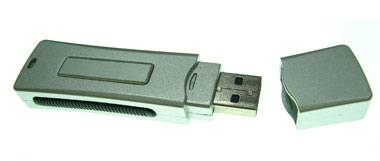As a nerdy kid, I still remember my dad bringing home the Mac Portable. I marveled at its form then, but there have been a few minor advances in technology here and there and now the Mac Portable has earned its nickname as the Mac Luggable. Imagine taking that thing to tackle some work at Starbucks. So, now that we’ve taken a little trip down memory lane it’s pretty easy to appreciate the options we have when it comes to working on the move—let’s take a look at some of the software that allows us to truly work from anywhere, whether the “portable office” includes your laptop or just some computer we’ve accosted at say, a relative’s place while supposedly on holiday. To achieve this mythical feat, we’ll be using…
Portable USB Apps
If you haven’t bought a USB flash drive yet, go and get one. You don’t have to use it for storage at all—I use a trusty external hard drive for that, but portable apps are the one thing that makes having a USB drive truly handy. No matter where you are, no matter whose computer you’re hijacking, you can plug it in and use a bunch of the best applications around without having to download and install them. Office Software OpenOffice is a fantastic free alternative to Microsoft Office, and I sure as hell haven’t come across a version of Microsoft Office that is sold for flash drives. There’s a word processor, a spreadsheet, a presentation designer and a database app—plus more. Everything you need to replace Office on the road, and it even opens Microsoft files. Get it for Windows and Mac. Communication Thunderbird is the not-quite-as-famous and somewhat-jealous sibling of Firefox, but despite its feelings of inadequacy it makes a great email app. It’s simple, yet has the power of any good desktop mail client. There’s a portable version for both Windows and Mac. Skype is a great communication tool, especially if you’ve put your phone bill on a diet. It does text communication well, though it is really renowned for its voice capabilities. I haven’t come across a way to get a portable OS X version, but with some tinkering you can make it portable for Windows—instructions here. For instant messaging, Pidgin can take care of pretty much any popular network. It was, in a former life, known as Gaim, the open source instant messenger. You can grab it for Windows. For Mac OS X, the equally versatile Adium is available as a portable app. Internet Browsing Presumably there’s a browser on the computer you’ve accosted, but don’t take the chance of having to bear with Internet Explorer. Or perhaps you want your bookmarks and various other settings with you. Either way, Firefox is available for both Windows and Mac, and is probably one of the most frequently used of all the portable apps. If only they had a Flock portable app. Organization Tools Sunbird, another sibling to Firefox, is a calendar program with task management capabilities. It’s even less famous than Thunderbird, but it’s good software as usual from Mozilla. Grab a copy for Windows or Mac. The organization arena of the portable apps world is one I find sorely lacking, and I wouldn’t mind playing with a GTD app for flash drives. Multimedia Audacity is a great, lightweight audio editor. I suppose most people don’t need an audio editor on the road, but as a recording musician this app has saved my butt a few times. If you do podcasting from strange places—a travel podcast, for instance—then it’s worth keeping this around. Get it for Windows or Mac. VLC is a video player that is a true lifesaver. I haven’t thrown a video at it that it couldn’t play, and chances are high that a randomly accosted computer isn’t packed to the brim with codecs. It’s also available on both Windows and Mac.
Secure Your Flash Drive
If you’re going to do any serious work with a flash drive setup, you’ll undoubtedly have information stored on there that you don’t want getting out. Whether it’s your address book, email, or files for a client project, you need to ensure that the drive is going to be secure. The easiest way to do this is with a password. Here’s one method to do it with TrueCrypt. If you don’t want to download more software, here’s another method for Mac users using Disk Utility. Remember, good solid password creation techniques are essential. Never use your middle name, your kid’s names, birthdays or your favorite band. Passwords that are a combination of numbers and letters work best, especially if you can do it in a way that’s easy for you to remember but not for anybody else. For instance, you could use tyti8mcp08 and memorize it as the year that I ate microwaved chocolate pudding, 2008. I bet you nobody will ever guess that one. If you can’t manage to memorize a password, you might just want to plonk down for a flash drive that has a fingerprint reader, though I imagine you’ll spend more time showing off to your friends than working with one of these monsters.
